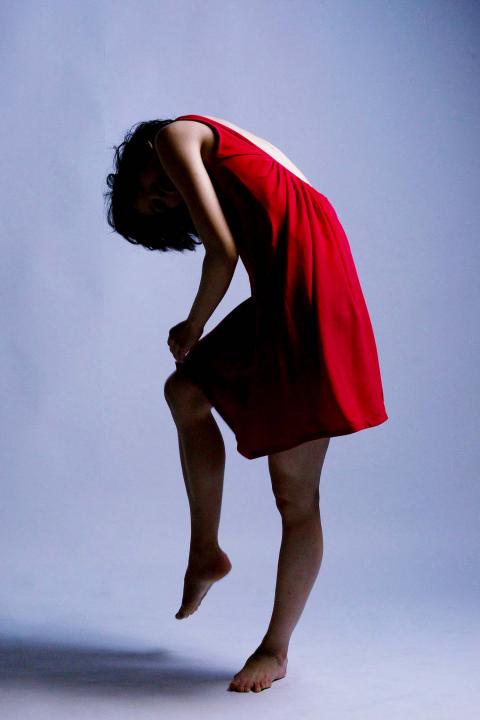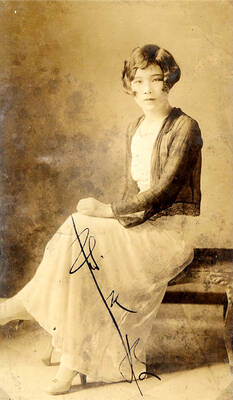I’ve seen several works by Taiwanese choreographer Cheng Tsung-lung (鄭宗龍) over the years — most of which were created for Cloud Gate 2 (雲門2). Still, his first full-length work, On the Road (在路上), came as a revelation at Saturday’s matinee at the Experimental Theater in Taipei.
Cheng has always been about no-frills precision: There’s never a wasted motion and he’s not interested in flashy costumes or stage props. Yet I was struck by a new maturity in his work and the confidence and command he demonstrated by going with just three dancers, an eclectic yet sparse soundtrack and a basic white set for the 70-minute work.
He divided the theater in half vertically, with the audience arrayed along the left wall, almost doubling the space for the dancers. Sitar player Usi AJ was tucked up almost at the audience’s feet on one end.

Photo Courtesy of Chen Chang-chih
Dancers Chiang Pao-shu (江保樹), Luo Sih-wei (駱思維) and Jhang Jian-hao (張堅豪) were out warming up as the audience took their seats, and were then onstage for the entire piece, including a three-minute break to towel off and change outfits that came about an hour into the work. Luo had the biggest load, partnering both Chiang and Jhang, but all three deserve kudos. Cheng credited Luo and Chiang for inspiring him over long talks about art and life during a trip to Yunnan, China.
On the Road is a journey through time (captured by the body art designs painted on the men’s chests that gradually bled through their white T-shirts), distance, musical traditions and friendship. As expansive as the journey was — the music ranged from traditional Naxi, Taiwanese folk music and sitar to Tom Waits’ Flower’s Grave and Western classical — the key was often in the small hand movements and the undulations of arms (and hips in a couple of places). The arms made it.
At Huashan 1914 Creative Park on Saturday night there were both pluses and minuses with Taiwanese dancer/choreographer turned producer Chou Shu-yi’s (周書毅) To Create — the Next Landscape (創造︰下一個風景), part of a choreographic collective called 2011 Next Choreography Project I (下一個編舞計畫 I). His team had to create both a stage and a viewing area from a bare-bones building with four big pillars in the middle, so sightlines were always going to be a problem.
Instead of just a center stage area, the choreographers also utilized the corners, which meant that half the audience had to shift seats for two of the dances. But if you were off to the left side, it was still difficult to see the floor portions of the other works.
The pluses in the six-choreographer program were Yeh Ming-hwa’s (葉名樺) Zero Time Moment (零時片刻), Lin Yu-ju’s (林祐如) Solo for Now and Yu Yen-fang’s (余彥芳) About Several Proposals That Have Disappeared (關於消失的幾個提議). Tien Hsiao-tzu’s (田孝慈) Tendon (莖) — with an umbilical cord of a bodysuit that began with leggings and a leotard and then had a long piece going from her neck all the way up to the second floor — had some interesting bits, but the faceless body of a woman hanging by a long cord of cloth creeped me out.
Yeh’s piece was very feminine and ethereal and a nice addition to her growing body of work. Lin is such a commanding dancer that it came as no surprise that her solo was the most straightforward of the lot, with a simple black top and pants costume and almost surgically precise movement. Yu’s soundtrack had lots of closing doors, footsteps in empty rooms and video clips of her in an empty hallway of the Huashan complex, but I felt the piece would have had more impact with a less flashy costume. (She wore a tarted-up French maid outfit with a black corset and a bright pink wig.)
There can be no more loyal dance fans in Taiwan than Cloud Gate Dance Theatre’s (雲門舞集). I couldn’t catch the company’s free performance of Water Stains on the Wall (屋漏痕) at the Chiang Kai-shek Memorial Hall Plaza on Saturday night, but I stopped by after Cheng’s matinee to see the preparations. Despite the strong sun and baking heat of the plaza, there were more than 100 people clustered in front of the stage at 4:30pm for the 7:30pm performance. Cloud Gate staffers told me the first audience member had arrived at 1pm.

Every now and then, it’s nice to just point somewhere on a map and head out with no plan. In Taiwan, where convenience reigns, food options are plentiful and people are generally friendly and helpful, this type of trip is that much easier to pull off. One day last November, a spur-of-the-moment day hike in the hills of Chiayi County turned into a surprisingly memorable experience that impressed on me once again how fortunate we all are to call this island home. The scenery I walked through that day — a mix of forest and farms reaching up into the clouds

With one week left until election day, the drama is high in the race for the Chinese Nationalist Party (KMT) chair. The race is still potentially wide open between the three frontrunners. The most accurate poll is done by Apollo Survey & Research Co (艾普羅民調公司), which was conducted a week and a half ago with two-thirds of the respondents party members, who are the only ones eligible to vote. For details on the candidates, check the Oct. 4 edition of this column, “A look at the KMT chair candidates” on page 12. The popular frontrunner was 56-year-old Cheng Li-wun (鄭麗文)

“How China Threatens to Force Taiwan Into a Total Blackout” screamed a Wall Street Journal (WSJ) headline last week, yet another of the endless clickbait examples of the energy threat via blockade that doesn’t exist. Since the headline is recycled, I will recycle the rebuttal: once industrial power demand collapses (there’s a blockade so trade is gone, remember?) “a handful of shops and factories could run for months on coal and renewables, as Ko Yun-ling (柯昀伶) and Chao Chia-wei (趙家緯) pointed out in a piece at Taiwan Insight earlier this year.” Sadly, the existence of these facts will not stop the

Oct. 13 to Oct. 19 When ordered to resign from her teaching position in June 1928 due to her husband’s anti-colonial activities, Lin Shih-hao (林氏好) refused to back down. The next day, she still showed up at Tainan Second Preschool, where she was warned that she would be fired if she didn’t comply. Lin continued to ignore the orders and was eventually let go without severance — even losing her pay for that month. Rather than despairing, she found a non-government job and even joined her husband Lu Ping-ting’s (盧丙丁) non-violent resistance and labor rights movements. When the government’s 1931 crackdown